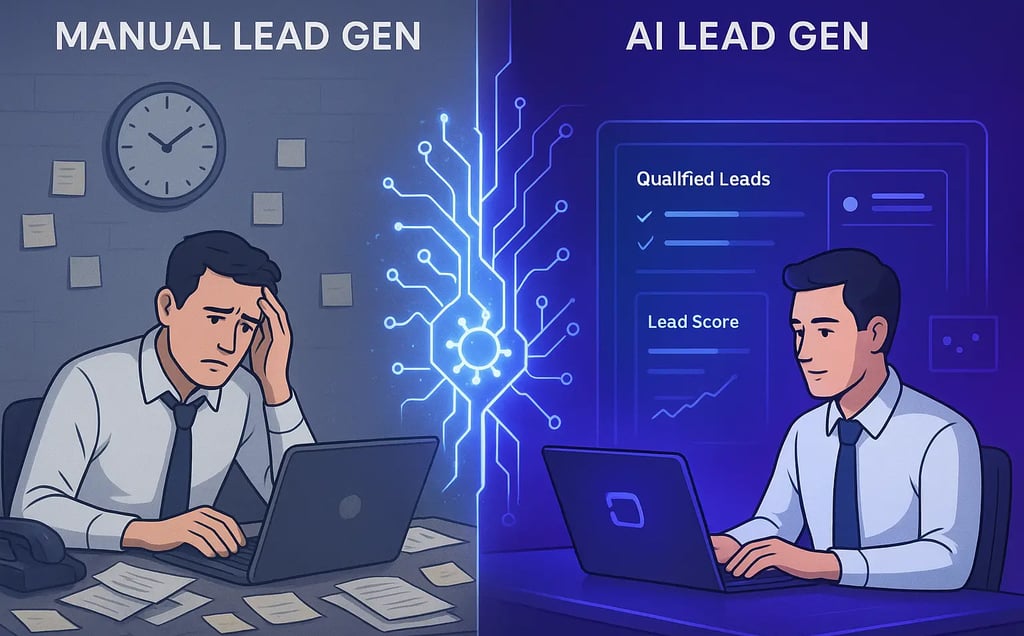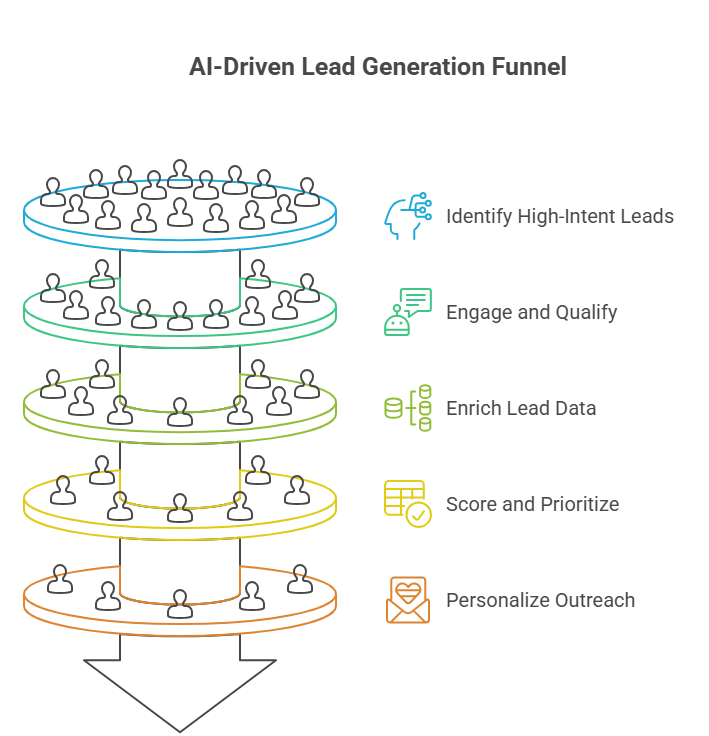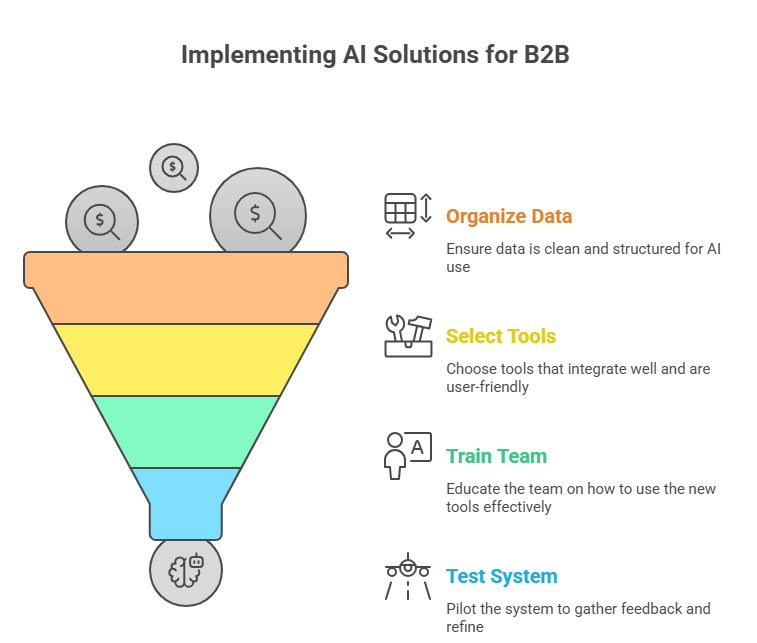The Definitive Guide to AI Lead Generation
SAASAUTOMATION
8/7/20257 min read


Let’s get real. Your sales team is probably your biggest expense.
So why are they spending nearly two-thirds of their day doing stuff that doesn’t actually make you money?
Think about it. They're digging through LinkedIn, manually typing names into your CRM, and sending out a thousand emails hoping one sticks. It’s not just a feeling. A big study from Salesforce confirmed that reps spend around 65% of their time on tasks that don't generate revenue.
It’s a huge bottleneck.
The solution? AI lead generation. And no, it’s not about firing your sales team. It's about giving them superpowers.
This is the definitive guide on how to use AI to find better leads, close more deals, and stop wasting time.
So, What Exactly is AI Lead Generation?
Forget the jargon.
AI lead generation is just using smart software to do the boring, repetitive parts of finding and talking to new customers.
Instead of a human sifting through data, an AI does it. Instead of a human typing the same qualifying questions over and over, a chatbot does it.
The result? Your sales team only talks to people who are actually interested and ready to buy. Companies doing this right are seeing up to a 50% jump in leads.
It's not magic, it's just efficiency.
Manual Lead Generation vs. AI Lead Generation
The way most companies still do lead gen is broken. It’s a recipe for burnout.
What Can AI Actually Do For Your Lead Generation?
AI can be woven into every stage of your sales funnel. Here’s how:
1. Find High-Intent Leads with Predictive Analytics
Stop guessing. AI analyzes your best customers to create a data-rich Ideal Customer Profile (ICP). It then scans the market for "twin" companies exhibiting buying signals – like recent funding, new executive hires, or increased content consumption on relevant topics – and serves them up to your team.
2. Engage and Qualify with AI Chatbots
Your website is a goldmine of potential leads. AI-powered chatbots engage visitors in real-time, natural conversations. They can answer complex product questions, qualify leads against your criteria (e.g., BANT), and book meetings directly on your sales team's calendars, turning your website into an autonomous lead-capturing machine.
3. Enrich Lead Data for Full Context
An email address alone is not a lead. AI enrichment tools transform a basic contact into a rich profile by automatically appending critical data points:
Firmographics: Company size, industry, revenue.
Technographics: The technologies they currently use.
Contact Data: Verified job titles and LinkedIn profiles.
Intent Signals: Real-time data on their research activities.
This empowers your sales team with the context needed for truly meaningful conversations.
4. Score and Prioritize Your Pipeline
AI lead scoring ends the "first-in, first-out" approach. It analyzes hundreds of data points to assign a numerical score to each lead, accurately predicting their likelihood to buy. This allows your team to ignore the noise and focus exclusively on hot, sales-ready opportunities.
5. Personalize Outreach at Unprecedented Scale
Personalization wins deals. AI makes it scalable. AI tools can generate thousands of unique, personalized emails or LinkedIn messages by referencing a prospect's job title, company news, or specific pain points derived from their online behavior. This drives response rates far beyond what generic templates can achieve.
Your 4-Step Game Plan to Get Started with AI
Look, this isn’t some "plug-and-play" magic trick. You need a plan.
At BriskFab, we build these systems for B2B companies every day. Here’s the simple framework we use.
Step 1: Find Out Where You're Leaking Money
Before you buy any tool, figure out your biggest problem.
Are your web leads going cold?
Is your sales team complaining about lead quality?
Are you sitting on a mountain of data you don't use?
Pick ONE big problem to solve first. Don’t try to do everything at once.
Step 2: Get Your Data in Order
AI runs on data. If your CRM data is a mess, your AI will be useless. Garbage in, garbage out.
You need to make sure your data is clean and organized. This is a non-negotiable step, and it's where a lot of companies get stuck. We actually help our clients build out their AI and data automation infrastructure first, because we know nothing works without it.
Step 3: Pick the Right Tools (and Don't Overcomplicate It)
You don’t need a dozen different apps. You just need a few solid ones that work together. When you’re looking at tools, ask yourself:
Does it connect to my CRM easily?
Can my team actually use this without expertise?
What’s the real cost (including setup)?
For a deeper dive, check out this in-depth guide on sales automation tools.
Step 4: Train Your Team and Test Everything
Don’t just dump a new tool on your team and expect them to love it.
Train them: Show them what a new AI lead score means and exactly what to do with it.
Pilot first: Launch your chatbot on one page, not your whole site. See how it does.
Get feedback: Listen to your team. They are on the front lines. Use their feedback to make the system better.
Building Your AI Lead Generation Stack
Okay, you're ready to look at tools. Here are the categories you need to think about, with popular, no-fluff examples.
1. Your CRM (The Brains): This is where everything lives. You need one with solid AI features built-in.
Examples: Salesforce Einstein, HubSpot AI.
2. Lead Intelligence (The Eyes & Ears): These tools find you contact info and tell you who is showing buying intent.
3. Conversational AI (The Mouthpiece): This is your 24/7 website greeter and qualifier.
4. Data Enrichment (The Analyst): These tools make sure your lead data is always complete and accurate.
5. Specialist Tools (The Superpowers): These are for next-level stuff like analyzing sales calls or making personalized videos.
AI for ABM & Intent Data: 6sense, Demandbase
Ready to Stop Wasting Time?
The bottom line is this: doing lead generation manually is like trying to win a car race on a bicycle. You're just going to get left behind.
According to research from Gartner, the majority of B2B sales organizations are already shifting to data-driven selling.
You have two choices:
Spend the next 6 months trying to figure all this out yourself.
Work with a partner who builds these AI lead generation systems day in, and day out.
At BriskFab, this is what we do. We help B2B tech companies build high-performance revenue engines, starting with a solid AI lead generation strategy. If you're curious to see how this could work for your business, with no fluff, let's chat.
Frequently Asked Questions (FAQs)
1. What is an example of AI lead generation ?
A top example in 2025 is the Autonomous Prospecting Agent. This AI finds real-time buying signals from sources like podcasts or developer forums, then uses a stack of tools like Apollo and Clay for deep, personalized research on target accounts. Based on its findings, the agent generates and sends a custom outreach –such as a personalized video via HeyGen—and manages the initial conversation, handing off only the qualified, meeting-ready leads to a human sales rep.
2. How does an AI system actually qualify a sales lead?
An AI qualifies a lead by using predictive lead scoring and data analysis. It looks at dozens of signals, including:
Firmographics: Company size, industry, location.
Technographics: The technology stack the company uses.
Behavioral Data: Which pages they visited, what content they downloaded.
Intent Data: Whether they are actively researching solutions like yours. The AI then assigns a score, allowing sales teams to instantly see which leads are hot and which are not worth their time.
3. What is the difference between AI lead generation and marketing automation?
The key difference is intelligence. Traditional marketing automation follows rigid, pre-set rules (e.g., "IF a user downloads an ebook, THEN send them this email sequence"). AI lead generation is dynamic and adaptive. It can understand the context of a conversation, make its own decisions based on complex data, and predict future behavior, making it far more powerful than simple rule-based automation.
3. What is the difference between AI lead generation and marketing automation?
The key difference is intelligence and adaptability. Traditional marketing automation follows rigid, pre-set rules you create (e.g., "IF a user downloads an ebook, THEN send this email sequence"). AI lead generation is dynamic; it can understand conversational context, predict which leads will convert based on complex data, and personalize outreach on its own. However, the best AI systems strategically involve a human-in-the-loop, allowing a person to review a list of AI-qualified leads or approve a generated email before it’s sent. This combines AI's speed and scale with essential human oversight and strategic judgment.
4. Can a small business use AI for lead generation?
Absolutely. The idea that AI is only for large enterprises is outdated. Many modern AI tools, including features within CRMs like HubSpot and outreach platforms like Apollo.io, are designed with affordable plans for small and medium-sized businesses. These tools allow smaller teams to automate tasks and compete effectively with larger companies.
5. How do you measure the ROI of AI lead generation?
The ROI of AI lead generation is measured by tracking key performance indicators (KPIs) like:
Increase in Marketing Qualified Leads (MQLs)
Improvement in Lead-to-Opportunity Conversion Rate
Reduction in Cost Per Acquisition (CPA)
Decrease in Sales Cycle Length By measuring these metrics before and after implementation, you can clearly demonstrate the financial impact of your AI tools.






